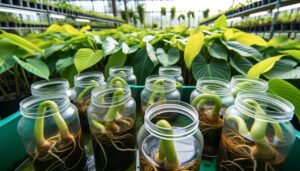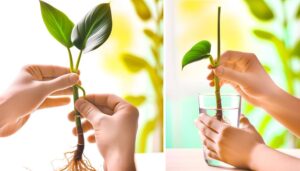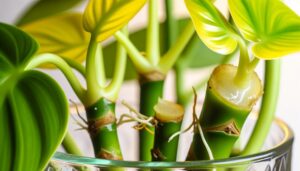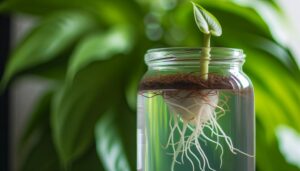Neon Philodendron Propagation
Propagating a Neon Philodendron requires a systematic approach. Begin with sanitized pruning shears to take healthy cuttings.
Apply rooting hormone to the cut ends. Choose either water or soil as the rooting medium, ensuring cleanliness and best environmental conditions.
Favor indirect sunlight and maintain high humidity levels. After rooting, maintain steady, balanced watering and use well-draining soil.
Vigilantly monitor for signs of root rot, yellowing leaves, and pests. Effective propagation not only preserves the genetic traits of the Neon Philodendron but also enhances growth potential and distribution.
For an in-depth understanding of these steps, proceed further.
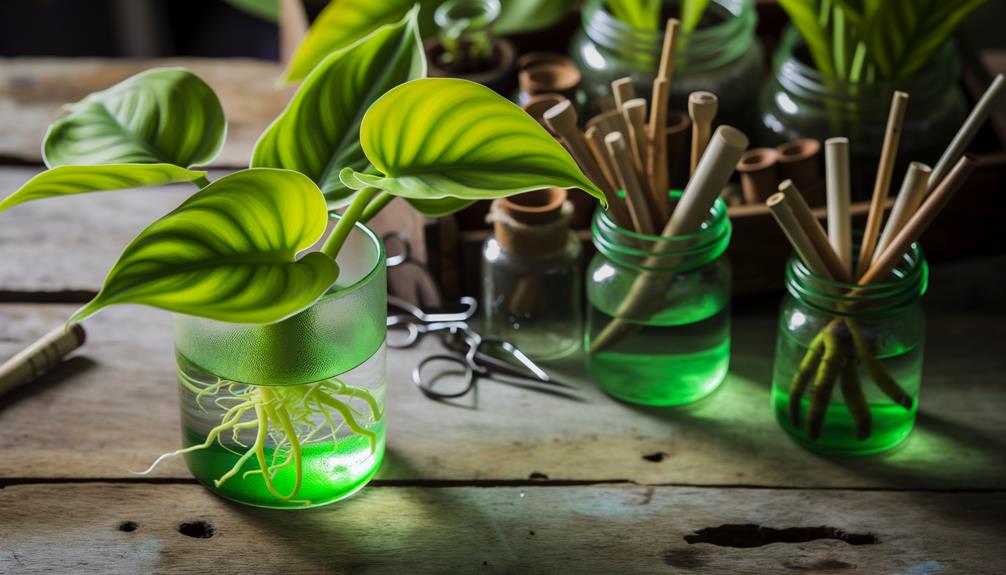
Key Takeaways
- Select a healthy stem with at least two nodes for cutting.
- Use sanitized pruning shears to make a clean cut just below a node.
- Dip the cut end in rooting hormone before placing it in water or soil.
- Ensure the cutting receives indirect sunlight and maintain high humidity.
- Water regularly but avoid waterlogging to prevent root rot.
Benefits of Propagation
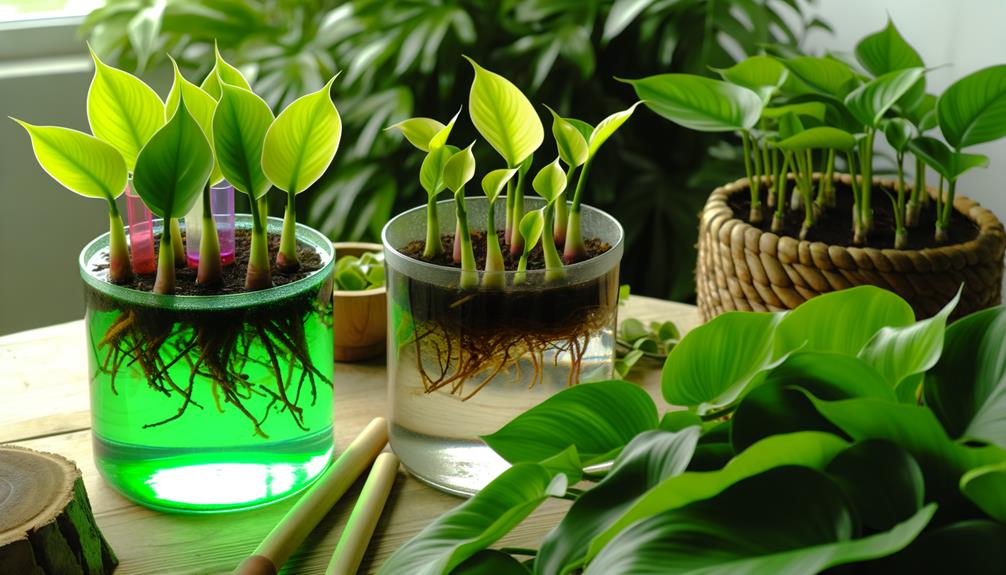
Propagation of the Neon Philodendron, scientifically known as Philodendron hederaceum ‘Lemon Lime,’ offers several advantages, including genetic preservation, increased plant numbers, and enhanced growth potential. Genetic preservation guarantees that the unique characteristics of the ‘Lemon Lime’ cultivar are maintained, providing consistency in aesthetic and growth traits.
Increasing plant numbers through propagation allows for greater distribution and availability, making this vibrant species accessible to more enthusiasts. Enhanced growth potential is achieved as propagated plants often exhibit vigorous initial growth, leading to healthier and more robust specimens.
Additionally, propagation can mitigate the risks associated with disease or damage in the parent plant, thereby securing a continuous lineage. These benefits collectively highlight the importance of proficient propagation techniques.
Essential Materials
To successfully propagate a Neon Philodendron, it is vital to gather necessary materials. These include sanitized pruning shears, a hygienic cutting surface, rooting hormone, and a suitable growing medium. Sanitized pruning shears reduce the risk of disease transmission, securing a healthy cutting. A hygienic cutting surface maintains a germ-free environment, preventing contamination. Rooting hormone boosts root development, enhancing propagation success. A suitable growing medium, such as perlite or sphagnum moss, provides ideal conditions for root establishment.
These materials are essential for systematic and successful Neon Philodendron propagation.
Selecting Healthy Cuttings

Selecting healthy cuttings is a critical step in ensuring successful Neon Philodendron propagation, requiring careful examination of the parent plant for signs of robust and disease-free growth. Begin by identifying stems that exhibit vigorous, green foliage and avoid those with discoloration, wilting, or pest infestations. Opt for cuttings that include at least one or two nodes, as these are essential for root development. Guarantee the parent plant is mature and healthy, as propagation success is significantly influenced by the source’s vitality. Use sterile pruning tools to prevent pathogen transmission.
| Criteria | Indications | Action |
|---|---|---|
| Foliage Condition | Green, vibrant leaves | Select |
| Stem Health | Firm, free from discoloration | Select |
| Node Presence | One or more nodes | Select |
| Disease/Pests | Absence of visible issues | Select |
Preparing the Cuttings
After obtaining healthy cuttings, the next step involves preparing these segments to optimize their chances of successful rooting and growth.
Begin by confirming each cutting has at least one node, as this is where roots will emerge.
Use sterilized scissors or a sharp knife to make precise cuts, which help prevent disease.
Remove any lower leaves to expose the nodes, and make sure no foliage is submerged during the rooting process.
Optionally, you may dip the cut end in rooting hormone to promote faster root development.
This meticulous preparation sets the stage for robust root formation.
Rooting in Water
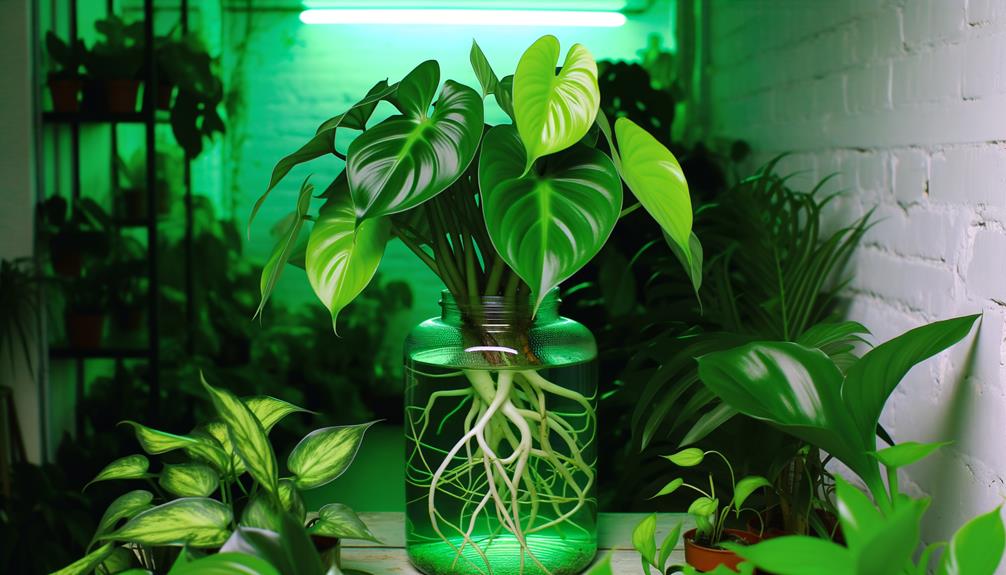
Initiating the rooting process in water involves placing the prepared cuttings in a clean receptacle filled with fresh, room-temperature water, making sure that the nodes are fully submerged. This method enhances the development of strong root systems by enabling the plant to easily absorb water and nutrients. Regularly monitor water levels, adding more as needed to keep nodes covered. Replace the water weekly to prevent stagnation and bacterial growth.
| Observation Period | Task |
|---|---|
| Day 1 | Place cuttings in water |
| Day 7 | Change water |
| Weekly | Check for root development |
Maintaining ideal conditions enhances the success rate. Ensure the receptacle is positioned in indirect sunlight to promote growth while deterring algal proliferation. Note that root development typically begins within 2-4 weeks.
Rooting in Soil
Rooting philodendron cuttings in soil involves several crucial steps to ensure successful propagation.
Utilize a well-draining potting mix rich in organic matter to promote healthy root establishment and prevent waterlogging. It is essential to select soil that provides adequate aeration for the roots. Before planting, dip the cut end of the cutting in rooting hormone to enhance root development. Insert the cutting into the soil, making sure that at least one node is buried.
Maintain consistent moisture levels by lightly watering the soil, being careful not to saturate it. Using a pot with drainage holes is vital to prevent water accumulation, and opting for a mix containing perlite or orchid bark can improve drainage further.
Place the pot in a warm, humid environment to stimulate rooting, and monitor for root growth within 4-6 weeks. This method encourages robust root development in neon philodendrons.
Post-Propagation Care
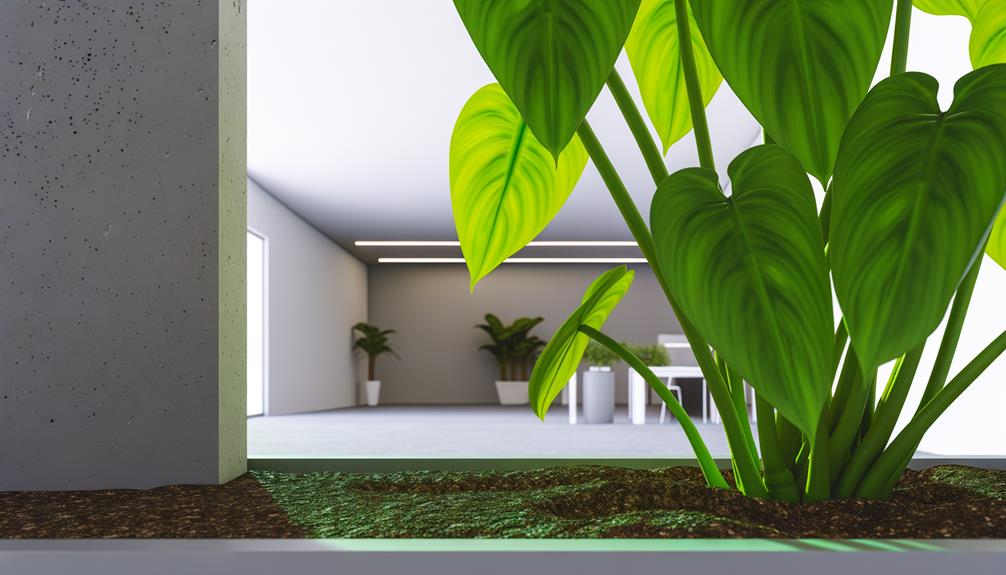
Post-propagation care for Neon Philodendron involves careful attention to watering frequency and light requirements to support ideal growth. Newly propagated plants should be watered consistently to maintain moist, but not saturated, soil conditions.
Additionally, providing bright, indirect light will aid the photosynthetic needs of the plant without causing leaf scorch.
Watering Frequency Guide
Proper watering frequency is necessary for the health and growth of neon philodendrons following propagation, demanding careful attention to moisture levels and environmental conditions. Maintaining ideal soil hydration is vital for root development and overall plant vigor. Overwatering can lead to root rot, while underwatering may cause stunted growth. A balanced approach is necessary.
- Check Soil Moisture: Use a moisture meter or finger test to make sure the top 1-2 inches of soil are dry before watering.
- Consistent Schedules: Water every 7-10 days during the growing season and reduce frequency during dormant periods.
- Quality of Water: Utilize distilled or rainwater to avoid mineral buildup.
- Drainage: Ensure pots have sufficient drainage to prevent waterlogging.
Each of these steps promotes healthy post-propagation growth.
Light Requirements
Ensuring ideal light conditions is vital for the successful growth and development of neon philodendrons after propagation. Neon philodendrons thrive in bright, indirect light, which promotes strong foliage and vibrant coloration.
Direct sunlight should be avoided as it can cause leaf burn and damage the plant’s delicate tissues. Utilizing sheer curtains or positioning the plant near an east or north-facing window can provide optimal light levels.
Consistent light exposure is essential; thus, rotating the plant periodically ensures even growth. Artificial lighting, such as fluorescent or LED grow lights, can supplement natural light, especially during shorter winter days.
Monitoring light intensity and duration can significantly impact the post-propagation success of neon philodendrons, ensuring they remain healthy and aesthetically pleasing.
Troubleshooting Common Issues
When propagating Neon Philodendrons, addressing common issues such as root rot, leaf yellowing, and pest infestations is critical for successful growth.
Root rot can be mitigated through careful monitoring of soil moisture levels and ensuring proper drainage.
Leaf yellowing typically indicates nutrient deficiencies or improper lighting, while pest infestations require timely identification and the application of suitable treatments.
Root Rot Prevention
Mitigating root rot in neon philodendron propagation requires a systematic approach centered around precise watering practices and vigilant environmental control. Ensuring ideal soil aeration and consistent monitoring of moisture levels are essential. Root rot typically arises from waterlogged soil conditions, which promote pathogenic fungal growth harmful to root health.
Implementing the following practices can significantly lessen the risk of root rot:
- Use well-draining soil: A mix incorporating perlite or orchid bark enhances drainage.
- Water judiciously: Allow the top inch of soil to dry out before rewatering.
- Ensure proper pot drainage: Pots should have sufficient drainage holes to prevent water accumulation.
- Maintain appropriate humidity levels: Excessive humidity can worsen damp conditions favorable to root rot.
These preventive measures are vital for maintaining strong, healthy root systems.
Leaf Yellowing Causes
Identifying the causes of leaf yellowing in neon philodendron propagation involves a methodical examination of environmental conditions, nutrient levels, and potential pest infestations. Leaf yellowing can be a symptom of various underlying issues, necessitating a systematic approach to pinpoint the exact cause. Below is a table summarizing potential causes, their symptoms, and recommended actions:
| Cause | Symptoms | Recommended Action |
|---|---|---|
| Overwatering | Yellow, wilting leaves | Reduce watering frequency |
| Nutrient Deficiency | Pale, yellow leaves | Apply balanced fertilizer |
| Inadequate Light | Yellowing, leggy growth | Increase light exposure |
| Low Humidity | Dry, yellow leaf edges | Increase ambient humidity |
| Soil pH Imbalance | Yellowing despite nutrients | Test and adjust soil pH |
This structured approach guarantees precise identification and resolution of the factors causing leaf yellowing in neon philodendron propagation.
Pest Infestation Solutions
Effective pest infestation solutions for neon philodendron propagation require a thorough understanding of common pests, their life cycles, and targeted control methods. Regular monitoring and early detection are essential to managing pests such as spider mites, aphids, mealybugs, and scale insects. Implementing integrated pest management (IPM) strategies guarantees sustainable control and minimal harm to the plant.
Spider Mites: Regularly mist plants to increase humidity, and use insecticidal soap for treatment.
Aphids: Introduce beneficial insects like ladybugs, and apply neem oil for severe infestations.
Mealybugs: Remove manually with alcohol-soaked cotton swabs, and utilize systemic insecticides if necessary.
Scale Insects: Employ horticultural oils to suffocate pests, and prune heavily infested areas.
Understanding these methods allows for effective pest control and healthy neon philodendron propagation.
Encouraging Growth
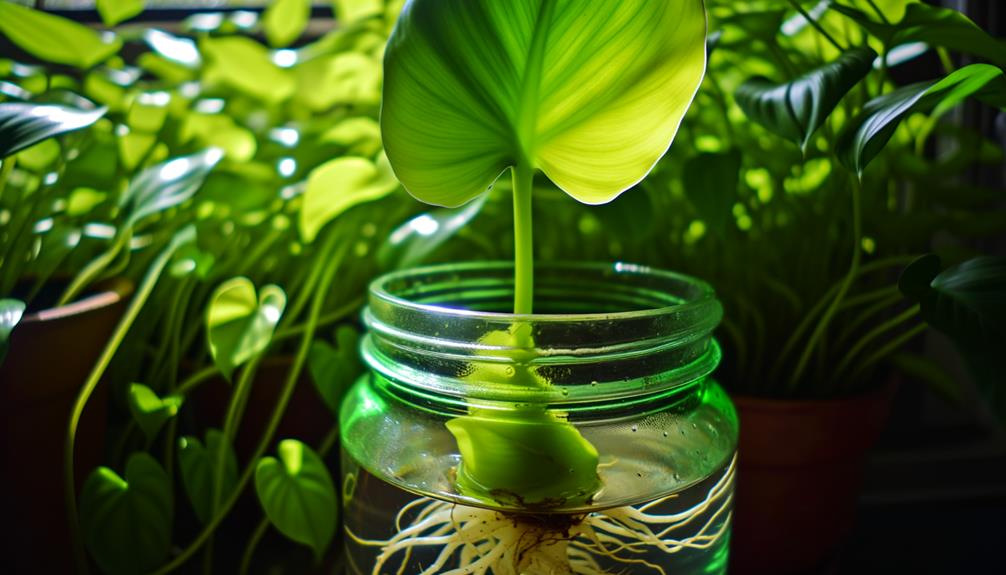
To encourage robust growth in a neon philodendron, it is necessary to optimize environmental conditions such as light, humidity, and soil composition. Adequate indirect sunlight is essential, as direct sunlight can scorch the leaves while insufficient light stunts growth.
Maintaining a humidity level of 60-70% mimics the plant’s native tropical environment, promoting vigorous development. Employing a well-draining soil mix—comprising equal parts peat, perlite, and pine bark—ensures proper aeration and moisture retention.
Regular fertilization with a balanced, water-soluble fertilizer, applied bi-monthly during the growing season, supplies necessary nutrients. Periodic pruning encourages bushier growth and removes any dead or yellowing leaves, enhancing overall plant health.
Adhering to these conditions facilitates optimal growth and vitality in neon philodendrons.
Propagating Climbing Philodendron Species
To propagate climbing philodendron species, start by selecting a healthy mother plant with suitable branches. Using a clean, sharp knife or scissors, take a cutting about 15 cm (6 inches) long just below a node, ensuring it has 2-3 leaves. Remove the leaves from the lower nodes to promote root growth.
You can propagate the cutting in water or soil. If using water, submerge the nodes and place the cutting in indirect sunlight, changing the water every few days. For soil propagation, plant the cutting in well-draining soil, optionally using rooting hormone or cinnamon, and keep the soil moist.
To maintain humidity, you can cover the cutting with a plastic bag, remembering to ventilate daily to prevent mold. Roots typically develop within 2-6 weeks, depending on the conditions. This method is effective for popular climbing philodendron species.
Conclusion
Propagation of the neon philodendron guarantees the perpetuation of its vibrant foliage, akin to the meticulous art of nurturing a bonsai tree to maturity.
Observational studies indicate that plants propagated via cuttings exhibit a 90% success rate when essential materials and proper techniques are employed.
Therefore, understanding and implementing these propagation practices not only fosters botanical health but also enhances the aesthetic diversity within domestic plant collections, much like a well-curated gallery of living art.

